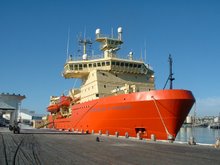(for dissolved gases) and I promised to tell more about the sampling
techniques. They are a weird blend of extreme delicacy and brute
force. As a "modeler" I have a tendency to gloss over the detailed
methods used to obtain oceanographic data -- there is a measure of
trust that the techniques work and that the data is accurate. After
all, these are "observations" of the real ocean, rather than output
from a computer. On top of this, the details of the sampling
techniques -- I mean the nitty gritty -- are not necessarily relayed
in papers.
The concentrations of the gases we are looking at are extremely
small, which has two effects. First, the sensitive equipment
required to analyze the samples is not practical to have on board --
so we have to collect water and send it back to the lab (hence the
water-catcher moniker). Second, we have to be extremely careful not
to compromise or change the sample, or contaminate it with gases that
were not in the water when it arrived on board. So knowing that,
here are the two techniques which I have spent considerable time
perfecting over the past month, in two installments.
For "noble gases" -- including two isotopes of helium, and neon -- we
use helium channels, which I discussed earlier, because we assembled
a few hundred in the first few days on board. Anyway, these consists
of a hollow aluminum rectangular "channel", about three feet long,
with steel clamps on each end, and a copper tube in the middle with
its ends sticking out between the clamps. When the CTD (and attached
rosette of 24 10 liter bottles) arrives, I attach plastic tubing to
both ends of the copper tube, find the bottles which I'm sampling
(each of which has been triggered at a specific depth) and attach one
end of the tubing to the valve at the base of each bottle. I test
the bottle to make sure it doesn't leak, then open the vent at the
top of the bottle. Pushing in the valve again starts the flow of
water. At this point I let water run through the tubing, the copper
tube, and out onto the floor through the plastic tube on the other
side, keeping the channel tipped up away from the bottle so air in
the tubing and channel can escape. Then I flip the channel over (so
copper tube and clamps are facing away from me), place the channel on
my thigh, and bang the channel for about 20 seconds with a mallet to
knock the bubbles out (which stick to the copper). Then I flip the
channel back over (keeping it upright), grab a pneumatic impact
wrench, center the copper tube in the channel, and drill the two
bolts on each clamp down so the clamps stop the flow of water in a
hurry (For those of you, who, like me a month ago, did not know whan
a pneumatic impact wrench is, it's what the use in auto repair shops
to bolt on hubcaps). It's like an indy-car pit stop. And it makes a
complete racket. And I get to do it 5 or 6 times at every station
(we've done close to 100 so far). How this method was developed, I
have no idea. But many people have thought about this and on a ship
in the middle of the Antarctic this is the best way to seal in the
few parts per billion that are the difference between water types.


No comments:
Post a Comment